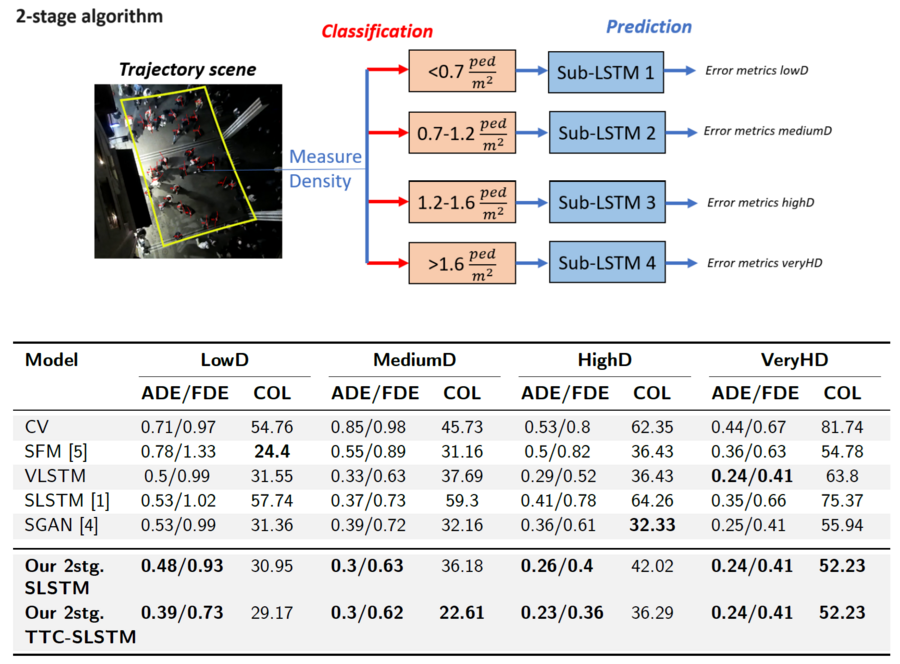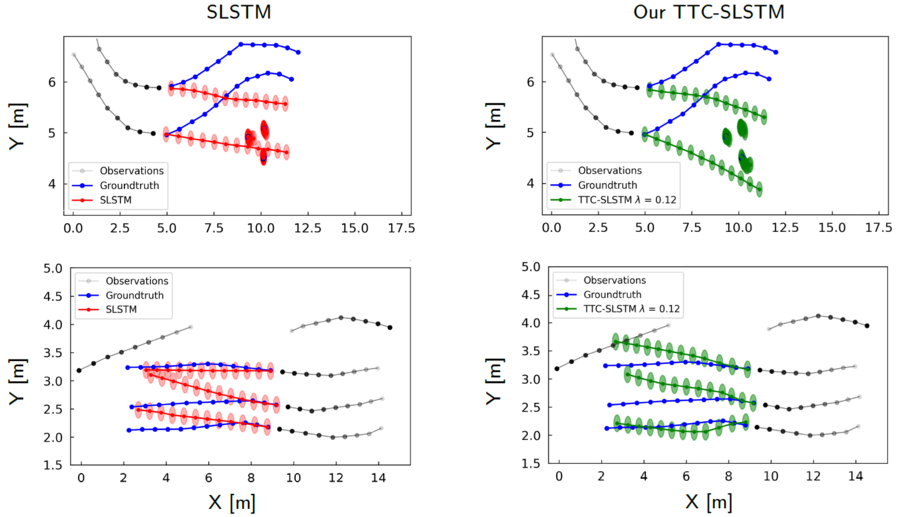Trajectory prediction by deep-learning
Classical operational pedestrian models rely on physical and social factors. They are defined by rules or generic mechanisms that depend on the local environment. Nowadays, there is an important trend in pedestrian trajectory prediction using deep learning approaches, based, among others, on the seminal studies by Alahi et al. with a Social Long Short-Term Memory recurrent neural network and Gupta et al. with a Social Generative Adversarial Networks. Applications include pedestrian movement in complex situations, pedestrian evacuation, autonomous vehicles, or robot motion planning in crowded environments.
On the one hand, knowledge-based models rely on a different equation with few physical parameters that can be physically interpreted. On the other hand, deep learning approaches are sophisticated algorithms with several hundred coefficients that have no known meaning. The approaches differ in terms of semantics, methodology, inputs/outputs, evaluation metrics, and also applications. Our research focuses on the development of new evaluation metrics that take into account pedestrian interactions, and the development of hybrid prediction algorithms that combine both approaches e.g. through residual modelling, knowledge-guided architecture and loss function, or synthetic data training.
- 2024
- R. Korbmacher and A. Tordeux, "Deep Learning for Predicting Pedestrian Trajectories in Crowds" in Intelligent Systems and Applications, Arai, Kohei, Eds. Cham: Springer Nature Switzerland, 2024, pp. 720-725.
- R. Korbmacher, H. Dang, A. Tordeux, B. Gaudou and N. Verstaevel, "Empirical comparison of different pedestrian trajectory prediction methods at high densities" in International Conference on Traffic and Granular Flow, 2024, pp. 231-238.
- R. Korbmacher, H. Dang and A. Tordeux, "Predicting pedestrian trajectories at different densities: A multi-criteria empirical analysis", Physica A: Statistical Mechanics and its Applications, vol. 634, pp. 129440, 2024.
- R. Korbmacher and A. Tordeux, "Toward better pedestrian trajectory predictions: the role of density and time-to-collision in hybrid deep-learning algorithms", Sensors, vol. 24, no. 7, pp. 2356, 2024.
- 2023
- C. Gnendiger, M. Chraibi and A. Tordeux, "Come together: A unified description of the escalator capacity", PLOS ONE, vol. 18, no. 3, pp. e0282599, 2023.
- J. Cordes, M. Chraibi, A. Tordeux and A. Schadschneider, "Single-File Pedestrian Dynamics: A Review of Agent-Following Models", Bellomo, Nicola and Gibelli, Livio, Eds. Cham: Springer International Publishing, 2023, pp. 143-178.
- R. Korbmacher, A. Nicolas, A. Tordeux and C. Totzeck, "Time-Continuous Microscopic Pedestrian Models: An Overview", Bellomo, Nicola and Gibelli, Livio, Eds. Cham: Springer International Publishing, 2023, pp. 55-80.
- H. Dang, R. Korbmacher, A. Tordeux, B. Gaudou and N. Verstaevel, "TTC-SLSTM: Human Trajectory Prediction Using Time-to-Collision Interaction Energy" in 2023 15th IEEE International Conference on Knowledge and Systems Engineering (KSE), 2023, pp. 1-6.
- 2022
- B. Khelfa, R. Korbmacher, A. Schadschneider and A. Tordeux, "Heterogeneity-induced lane and band formation in self-driven particle systems", Scientific Reports, vol. 12, no. 1, pp. 1-11, 2022. Nature Publishing Group.
- B. Khelfa, R. Korbmacher, A. Schadschneider and A. Tordeux, "Initiating lane and band formation in heterogeneous pedestrian dynamics", Collective Dynamics, vol. 6, pp. 1-13, 2022.
- R. Subaih, M. Maree, A. Tordeux and M. Chraibi, "Questioning the anisotropy of pedestrian dynamics: An empirical analysis with artificial neural networks", Applied Sciences, vol. 12, no. 15, pp. 7563, 2022. MDPI.
- R. Korbmacher and A. Tordeux, "Review of pedestrian trajectory prediction methods: Comparing deep learning and knowledge-based approaches", IEEE Transactions on Intelligent Transportation Systems, vol. 23(12), pp. 24126-24144, 2022. IEEE.
- J. Cordes, M. Chraibi, A. Tordeux and A. Schadschneider, "Time-to-collision models for single-file pedestrian motion", Collective Dynamics, vol. 6, pp. 1-10, 2022.
- 2019
- A. Tordeux, M. Chraibi, A. Seyfried and A. Schadschneider, "Artificial neural networks predicting pedestrian dynamics in complex buildings" in Workshop on Stochastic Models, Statistics and their Application, 2019, pp. 363-372.
- A. Tordeux, M. Chraibi, A. Seyfried and A. Schadschneider, "Prediction of pedestrian dynamics in complex architectures with artificial neural networks", Journal of Intelligent Transportation Systems, vol. 24, no. 6, pp. 556-568, 2019. Taylor & Francis.
- A. Tordeux, M. Chraibi, A. Seyfried and A. Schadschneider, "Prediction of pedestrian speed with artificial neural networks" in International Conference on Traffic and Granular Flow, 2019, pp. 327-335.
Further references
G Saporta. Models for Understanding versus Models for Prediction. COMPSTAT 2008, pp. 315-322, 2008. Presentation
A Alahi, K Goel, V Ramanathan, A Robicquet, L Fei-Fei, S Savarese. Social LSTM: Human trajectory prediction in crowded spaces. In Proceedings of the IEEE Conference on Computer Vision and Pattern Recognition, pp. 961-971, 2016.
A Gupta, J Johnson, L Fei-Fei, S Savarese, A Alahi. Social GAN: Socially acceptable trajectories with generative adversarial networks. In Proceedings of the IEEE Conference on Computer Vision and Pattern Recognition, pp. 2255-2264, 2018.
Here are some posters (Poster1, Poster2) and presentation slides (Pres1, Pres2) about the prediction of pedestrian trajectories using deep learning algorithms.




